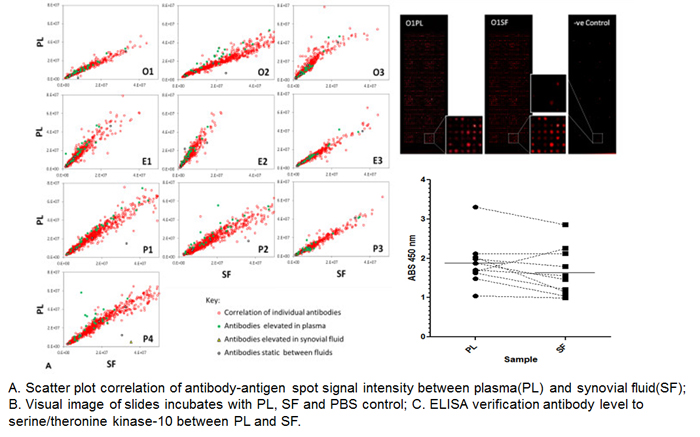LaBaer Lab | Home
Arthritis
Rheumatoid Arthritis | Juvenile Arthritis | Publications
Rheumatoid Arthritis
Investigator: Ji Qiu, Ph.D.
Collaborators: Jerry Nepom, Ph.D. (Benaroya Research Institute), and Jane Buckner (Benaroya Research Institute)
Disease Background
| Who gets it? What are the symptoms?
|
How do we detect it now? How is it currently treated?
|
What are the current challenges?
|
Our Approach
Anti-citrulline antibodies are specific and predictive of rheumatoid arthritis (RA). Seropositivity against citrulline is clinically assayed using cyclic citrullinated peptide (CCP) ELISA. Despite being an excellent proxy assay for diagnosis, anti-CCP positivity does not reveal any information about the actual underlying antigens that elicited the immune response. Recent studies demonstrated the value of identifying autoantibodies to particular antigens in the elucidation of RA etiology. Furthermore, the use of specific citrullinated antigens could improve diagnostic performance. Unfortunately, only a few citrullinated antigens have been discovered in the past several decades. Traditional protein immuno-chemistry methods to identify citrullinated antigens suffer drawbacks such as low throughput, poor reproducibility, inadequate quantification and low resolution. Commercial protein arrays are expensive, lack equal representation of candidate antigens and are not compatible with post-translational modifications such as citrullination, which requires harsh conditions. Our overarching goal is to discover additional antigens, when citrullinated, can be recognized by antibodies in RA patients at the proteome level. Identification of these citrullinated antigens will not only help understand the disease pathogenesis but also improve diagnosis and patient stratification.
Juvenile Idiopathic Arthritis
Investigator: Ji Qiu, Ph.D.
Collaborators: David Gibson (Queens University)
Disease Background
Who gets it?
What are the symptoms?
|
How do we detect it now?
How is it currently treated?
|
What are the current challenges?
|
Our Approach
 Similar to Rheumatoid Arthritis,
we expect to identify autoantibodies using NAPPA that provide diagnostic biomarkers for this disease.
Similar to Rheumatoid Arthritis,
we expect to identify autoantibodies using NAPPA that provide diagnostic biomarkers for this disease.
Publications
Gibson DS, Qiu J, Mendoza EA, Barker K, Rooney ME, LaBaer J. Circulating and synovial antibody profiling of juvenile arthritis patients by nucleic acid programmable protein arrays. Arthritis Res Ther. Apr 17;14(2):R77. [Epub ahead of print] Abstract

